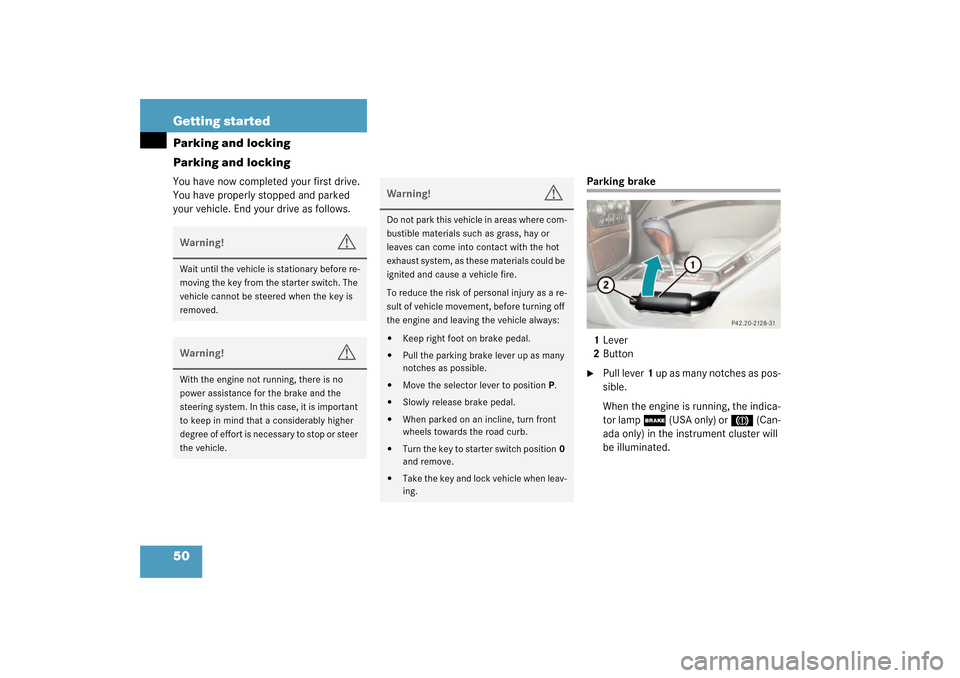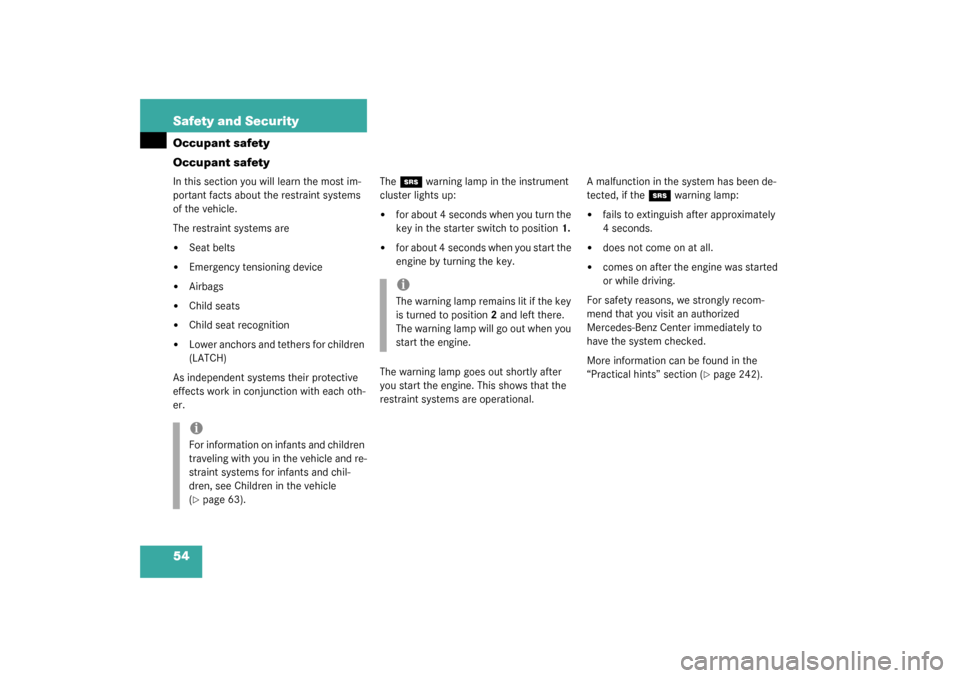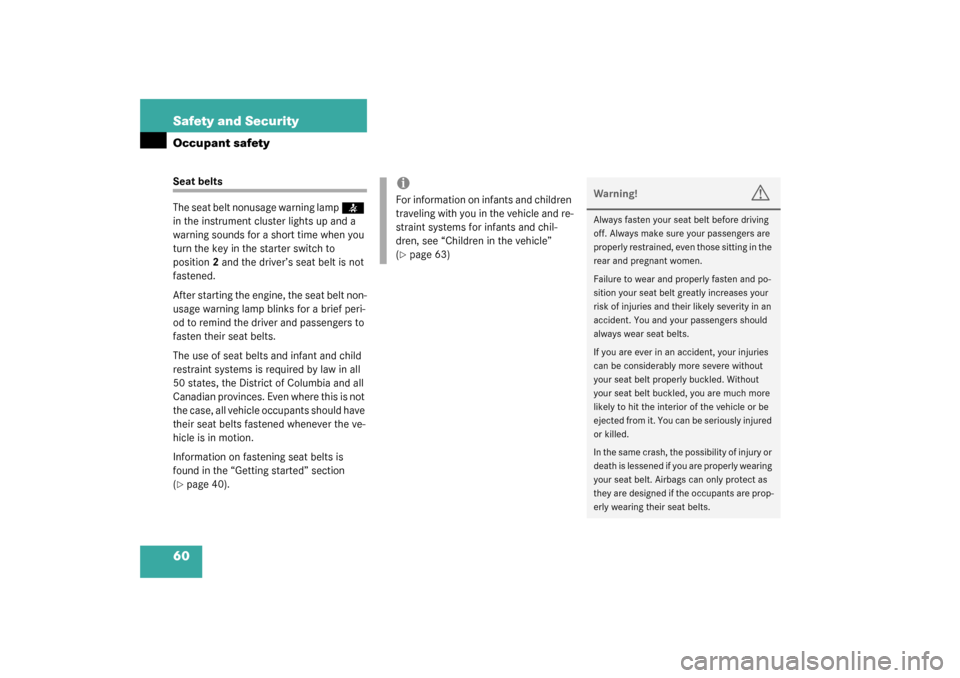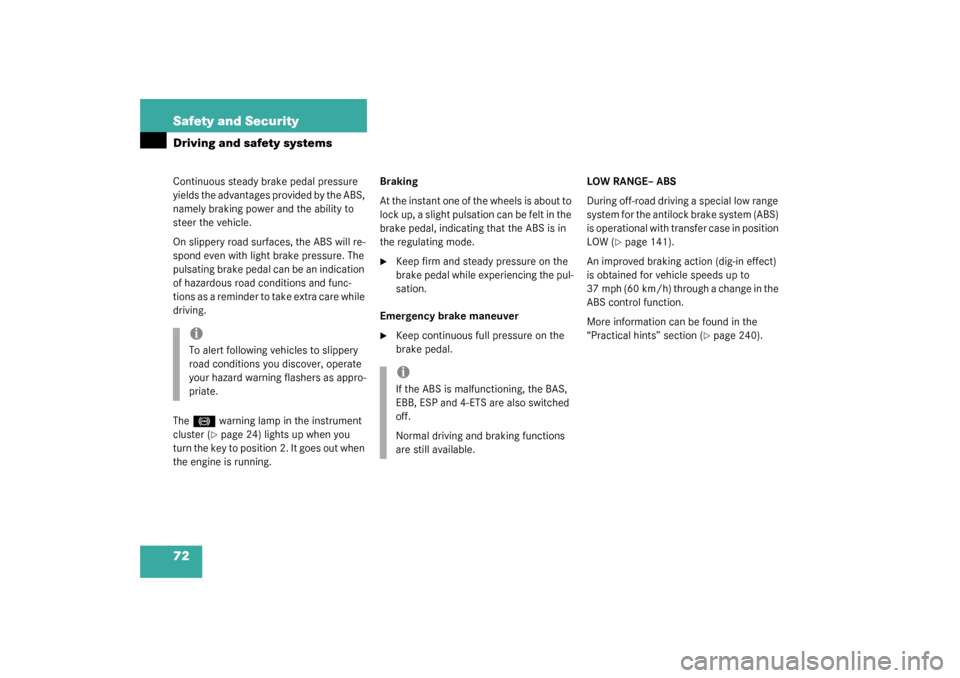Page 39 of 360
39 Getting started
Adjusting
�
Make sure that the ignition is switched
on.
All the lights in the instrument cluster
light up.
�
Press button2 for left mirror or
button3 for right mirror.
�
Push adjustment button1 up, down,
left or right according to the setting de-
sired.
More information can be found in the
“Controls in detail” section (
�page 99).
iThe memory function (
�page 97) can
be used to save the exterior mirror set-
tings together with the seat and steer-
ing wheel settings.
!If an exterior rear view mirror housing
is forcibly pushed forward or rearward,
reposition it by applying firm pressure
until it snaps into place. The mirror
housing is now properly positioned and
you can adjust the mirror normally.
Page 45 of 360

45 Getting started
Driving
�
Release the parking brake by lifting
lever1 up slightly, pressing button2
on the lever and moving lever1 down
to the stop.
The indicator lamp
;
(USA only) or
3
(Canada only) in the instrument
cluster goes out.
Driving
�
Depress the brake pedal.
The selector lever lock is released.
�
Move selector lever to positionD orR.
�
Release the brake pedal.
�
Carefully depress the accelerator.
Once the vehicle is in motion, the auto-
matic central locking system engages
and the locking knobs drop down.After a cold start, the automatic transmis-
sion engages at a higher revolution. This al-
lows the catalytic converter to reach its
operating temperature earlier.
More information on driving can be found
in “Operation” section (
�page 197).
For information on off-road driving, see
“Driving instructions” (
�page 203).
iWait for the gear selection process to
complete before setting the vehicle in
motion.
iYou can open the doors from inside at
any time. Open doors only when the
conditions are safe to do so.!If you hear a warning signal when driv-
ing off, you have forgotten to release
the parking brake.
Release the parking brake.
Warning!
G
It is dangerous to shift the selector lever out
ofP or N if the engine speed is higher than
idle speed. If your foot is not firmly on the
brake pedal, the vehicle could accelerate
quickly forward or in reverse. You could lose
control of the vehicle and hit someone or
something. Only shift into gear when the en-
gine is idling normally and when your right
foot is firmly on the brake pedal.Warning!
G
On slippery road surfaces, never downshift
in order to obtain braking action. This could
result in drive wheel slip and reduced vehi-
cle control. Your vehicle’s ABS will not pre-
vent this type of loss of control.
Page 46 of 360
46 Getting startedDrivingSwitching on headlampsExterior lamp switch1Off
2Low beam headlamps on�
Turn the switch to
B
.
More information can be found in the
“Controls in detail” section (�page 100).
Turn signals and high beam
The combination switch is on the left of the
steering column.Combination switch1Turn signals, right
2Turn signals, left�
Press combination switch up1 or
down2.
The switch is automatically canceled
when the steering wheel is turned a
sufficient degree.High beam
�
Push the combination switch forward.
The high beam symbol
A
in the
instrument cluster lights up.
More information can be found in the
“Controls in detail” section (
�page 103).
iTo signal minor directional changes,
move combination switch to point of
resistance only and release. The turn
signal blinks three times.
Page 50 of 360

50 Getting startedParking and locking
Parking and lockingYou have now completed your first drive.
You have properly stopped and parked
your vehicle. End your drive as follows.
Parking brake
1Lever
2Button�
Pull lever1 up as many notches as pos-
sible.
When the engine is running, the indica-
tor lamp
;
(USA only) or
3
(Can-
ada only) in the instrument cluster will
be illuminated.
Warning!
G
Wait until the vehicle is stationary before re-
moving the key from the starter switch. The
vehicle cannot be steered when the key is
removed.Warning!
G
With the engine not running, there is no
power assistance for the brake and the
steering system. In this case, it is important
to keep in mind that a considerably higher
degree of effort is necessary to stop or steer
the vehicle.
Warning!
G
Do not park this vehicle in areas where com-
bustible materials such as grass, hay or
leaves can come into contact with the hot
exhaust system, as these materials could be
ignited and cause a vehicle fire.
To reduce the risk of personal injury as a re-
sult of vehicle movement, before turning off
the engine and leaving the vehicle always:�
Keep right foot on brake pedal.
�
Pull the parking brake lever up as many
notches as possible.
�
Move the selector lever to positionP.
�
Slowly release brake pedal.
�
When parked on an incline, turn front
wheels towards the road curb.
�
Turn the key to starter switch position0
and remove.
�
Take the key and lock vehicle when leav-
ing.
Page 54 of 360

54 Safety and SecurityOccupant safety
Occupant safetyIn this section you will learn the most im-
portant facts about the restraint systems
of the vehicle.
The restraint systems are�
Seat belts
�
Emergency tensioning device
�
Airbags
�
Child seats
�
Child seat recognition
�
Lower anchors and tethers for children
(LATCH)
As independent systems their protective
effects work in conjunction with each oth-
er.The
1
warning lamp in the instrument
cluster lights up:
�
for about 4 seconds when you turn the
key in the starter switch to position1.
�
for about 4 seconds when you start the
engine by turning the key.
The warning lamp goes out shortly after
you start the engine. This shows that the
restraint systems are operational.A malfunction in the system has been de-
tected, if the
1
warning lamp:
�
fails to extinguish after approximately
4seconds.
�
does not come on at all.
�
comes on after the engine was started
or while driving.
For safety reasons, we strongly recom-
mend that you visit an authorized
Mercedes-Benz Center immediately to
have the system checked.
More information can be found in the
“Practical hints” section (
�page 242).
iFor information on infants and children
traveling with you in the vehicle and re-
straint systems for infants and chil-
dren, see Children in the vehicle
(�page 63).
iThe warning lamp remains lit if the key
is turned to position2 and left there.
The warning lamp will go out when you
start the engine.
Page 60 of 360

60 Safety and SecurityOccupant safetySeat belts
The seat belt nonusage warning lamp
<
in the instrument cluster lights up and a
warning sounds for a short time when you
turn the key in the starter switch to
position2 and the driver’s seat belt is not
fastened.
After starting the engine, the seat belt non-
usage warning lamp blinks for a brief peri-
od to remind the driver and passengers to
fasten their seat belts.
The use of seat belts and infant and child
restraint systems is required by law in all
50 states, the District of Columbia and all
Canadian provinces. Even where this is not
the case, all vehicle occupants should have
their seat belts fastened whenever the ve-
hicle is in motion.
Information on fastening seat belts is
found in the “Getting started” section
(
�page 40).
iFor information on infants and children
traveling with you in the vehicle and re-
straint systems for infants and chil-
dren, see “Children in the vehicle”
(�page 63)
Warning!
G
Always fasten your seat belt before driving
off. Always make sure your passengers are
properly restrained, even those sitting in the
rear and pregnant women.
Failure to wear and properly fasten and po-
sition your seat belt greatly increases your
risk of injuries and their likely severity in an
accident. You and your passengers should
always wear seat belts.
If you are ever in an accident, your injuries
can be considerably more severe without
your seat belt properly buckled. Without
your seat belt buckled, you are much more
likely to hit the interior of the vehicle or be
ejected from it. You can be seriously injured
or killed.
In the same crash, the possibility of injury or
death is lessened if you are properly wearing
your seat belt. Airbags can only protect as
they are designed if the occupants are prop-
erly wearing their seat belts.
Page 72 of 360

72 Safety and SecurityDriving and safety systemsContinuous steady brake pedal pressure
yields the advantages provided by the ABS,
namely braking power and the ability to
steer the vehicle.
On slippery road surfaces, the ABS will re-
spond even with light brake pressure. The
pulsating brake pedal can be an indication
of hazardous road conditions and func-
tions as a reminder to take extra care while
driving.
The
-
warning lamp in the instrument
cluster (�page 24) lights up when you
turn the key to position 2. It goes out when
the engine is running.Braking
At the instant one of the wheels is about to
lock up, a slight pulsation can be felt in the
brake pedal, indicating that the ABS is in
the regulating mode.
�
Keep firm and steady pressure on the
brake pedal while experiencing the pul-
sation.
Emergency brake maneuver
�
Keep continuous full pressure on the
brake pedal.LOW RANGE– ABS
During off-road driving a special low range
system for the antilock brake system (ABS)
is operational with transfer case in position
LOW (
�page 141).
An improved braking action (dig-in effect)
is obtained for vehicle speeds up to
37 mph (60 km/h) through a change in the
ABS control function.
More information can be found in the
“Practical hints” section (
�page 240).
iTo alert following vehicles to slippery
road conditions you discover, operate
your hazard warning flashers as appro-
priate.
iIf the ABS is malfunctioning, the BAS,
EBB, ESP and 4-ETS are also switched
off.
Normal driving and braking functions
are still available.
Page 83 of 360
83 Controls in detail
Locking and unlocking
Seats
Memory function
Lighting
Instrument cluster
Control system
Automatic transmission
Transfer case
Differential locks
Good visibility
Climate control
Power windows
Sliding/pop-up roof
Driving systems
Loading
Useful features